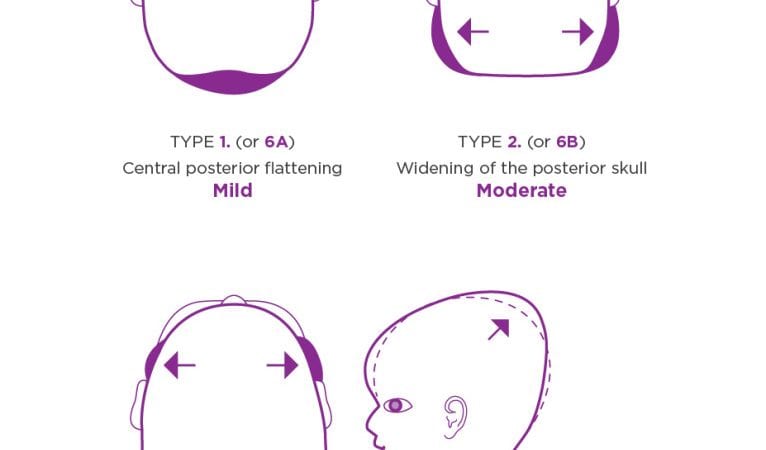Brachycephaly is a condition characterised by a flattened area at the back of the skull. Most parents notice their baby’s brachycephalic head shape when their baby is around eight weeks of age, with their baby’s head appearing wider than expected and their ears sometimes being pushed outwards. Please keep reading for more information on how to define a brachycephaly head shape.
The brachycephaly definition is: having a relatively broad, short skull (typically with the breadth at least 80 per cent of the length).
Brachycephaly can also involve a slight bulging of the forehead and a wide brow. The typical treatment for brachycephaly includes repositioning or a specialist orthotic helmet. For babies with brachycephaly, the head is also often higher at the back and the whole back of the head can appear completely flat, with the absence of any rounding towards the neck. Brachycephaly is a form of flat head syndrome and can be found either in isolation or in combination with plagiocephaly. Find out more about the signs of brachycephaly in our blog post outlining 4 indications of a brachycephalic head shape.

For parents who have recognised a flat area on their baby’s head, it can be confusing to decipher between the plagiocephaly and brachycephaly, but our blog on the difference between plagiocephaly and brachycephaly offers guidance and how understanding on how they tie in with flat head syndrome.
What Causes Brachycephaly?
Brachycephaly develops when the natural growth of a baby’s head meets external pressure, which in turn inhibits growth to that area of the head. During early infancy, a baby’s skull is still soft enough to be moulded by these external pressures, which can lead to areas of the skull becoming misshapen and result in brachycephaly.
There are various brachycephaly causes of this external pressure, which can either be prenatally in the mother’s womb or as a result of external pressures outside of the womb. The most common brachycephaly causes are:
Positional Causes of Brachycephaly
Pressure during sleep: babies are born with a soft, pliable skull which tends to develop during infancy. A flattening of the skull can occur if your baby has a tendency to sleep in one position each night, therefore applying pressure to the same area of their head. As the flattened area develops, your baby may then become even more accustomed to that particular position, enhancing the flattening further. Or, their head may naturally roll into that position.
This cause of brachycephaly is particularly common due to the sleep advice given to parents. The Back to Sleep campaign advises parents to place their babies on their back to sleep, to help avoid Sudden Infant Death Syndrome (SIDS). Despite its effect on the prevalence of flat head syndrome, we are true advocates of the very successful Back to Sleep campaign and do not recommend that parents stop following this advice. Since this fantastic campaign began, the number of babies who have suffered cot death has dramatically reduced.
Congenital Causes of Brachycephaly
Large head size: some babies simply have larger head sizes than others and the muscles of a very young baby are not able to move the head away from a flattened position.
Prenatal moulding during birth: a baby could be born with a brachycephaly head shape due to positioning in the womb or descent into the birth canal. We often see babies who have been in the back to back position prenatally.
Hydramnios (low amniotic fluid level): when the mother’s amniotic sac doesn’t contain enough fluid, there is also less cushioning in the womb. Additionally, if there are multiple babies in the womb, such as twins, this causes ‘crowding’ in the uterus. This prenatal environment may place excess pressure on the baby’s skull and result in brachycephalic head shape.
If you suspect that your little one has brachycephaly and would like to find out more information and get a professional diagnosis, contact us. Our friendly and professional clinicians will advise you on the best possible course of action to take for you and your baby.


